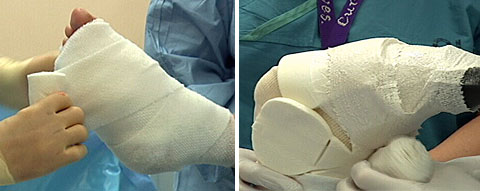 |
|
Kerlix fluffs
are being
used to ensure INTEGRA™ Bilayer Matrix Wound
Dressing is in complete contact with the wound bed
|



In this case, cotton cast padding followed by a bias
stockinet and total contact cast was used to
ensure INTEGRA™ Bilayer
Matrix Wound Dressing remained in contact with
the wound bed
Outer Dressings
Note:
Do not let Dakins Solution, petroleum-based
products, e.g., Xeroform, or enzymatic debridement agents,
(e.g., Collagenase), come in contact with the INTEGRA™
Bilayer Matrix Wound Dressing application sites.
Use splints or bolsters, per unit protocols, during first
5-7 days. Splints should be applied and should stay on
at all times (except when performing wound care).
The VAC (Vacuum Assisted Closure)* may be used over unmeshed
or meshed INTEGRA™ Bilayer Matrix Wound Dressing
sites, in particular, as a bolster dressing for difficult
anatomical sites or wound beds, such as the axilla.
*VAC is a registered trademark of Kinetic Concepts, Inc.
(KCI)